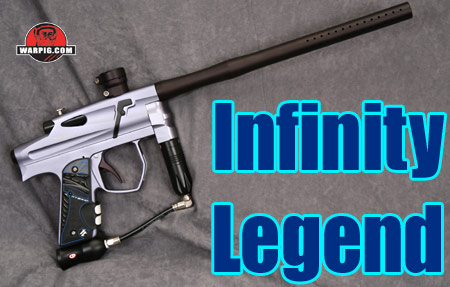
Infinity Legend
by Bill Mills - Photos
by Dawn Mills - April 2007
Overview
- How It Works - Disassembly
- Testing - Raw Test
Data
The names Dave Zinkham and Glen Forester have appeared numerous times on WARPIG's pages over the years. Forster has played his way to a world championship as a professional player, and been involved in the paintball industry, managing a retail store in Southern California, while still having time to help shape tournament paintball by sitting on the NPPL Rules Committee. Zinkham is an engineer who has worked on a number of paintball related projects, and become the NPPL's scrutineer (referee focused on enforcement of the equipment rules) and more recently the league's ultimate judge.
Collaboration between the pair has produced the Legend, a lightwight stacked tube electropneumatic paintgun, built with the serious tournament player in mind.
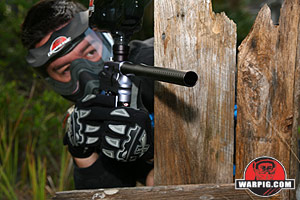 The layout of the Legend is pretty straightforward for a stacked tube marker. It's body is roughly rectangular in shape, with a tube hollowed out of the upper half for the bolt and breech, while another tube hollowed out of its lower half contains the exhaust valve and pneumatic ram/hammer assembly. Both the upper and lower tubes are each of a single diameter from end to end, aside from the barrel fitting at the front of the upper tube.. The layout of the Legend is pretty straightforward for a stacked tube marker. It's body is roughly rectangular in shape, with a tube hollowed out of the upper half for the bolt and breech, while another tube hollowed out of its lower half contains the exhaust valve and pneumatic ram/hammer assembly. Both the upper and lower tubes are each of a single diameter from end to end, aside from the barrel fitting at the front of the upper tube..
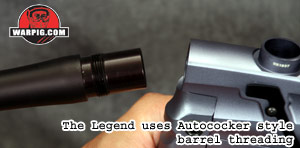 The Legend utilizes WGP Autococker style barrel threads for attaching its barrel, as they are a well accepted industry standard. The stock barrel is made of aluminum, and is 14 inches in length. The Legend utilizes WGP Autococker style barrel threads for attaching its barrel, as they are a well accepted industry standard. The stock barrel is made of aluminum, and is 14 inches in length.
 Six rows of straight line porting holes are drilled into the last five inches up the the muzzle. A gentle curve to the barrel's outer wall about 1/3 of the length up from the breech keeps its shape from being boringly straight, and offers additional rigidity to that section. Six rows of straight line porting holes are drilled into the last five inches up the the muzzle. A gentle curve to the barrel's outer wall about 1/3 of the length up from the breech keeps its shape from being boringly straight, and offers additional rigidity to that section.
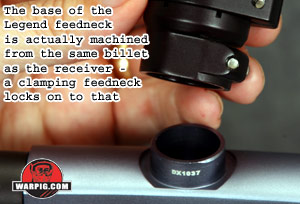 The feedneck of the Legend is of an unusual design. Most marker feednecks screw into the receiver of the paintgun. This requires that fine screw threads be cut into the neck and the body, which works well, unless they become stripped. As the receiver is usually one of the most expensive parts of a marker, having one ruined by a stripped feedneck can be a very disappointing experience – and one that has happened to players that put their markers through heavy abuse on the field. The feedneck of the Legend is of an unusual design. Most marker feednecks screw into the receiver of the paintgun. This requires that fine screw threads be cut into the neck and the body, which works well, unless they become stripped. As the receiver is usually one of the most expensive parts of a marker, having one ruined by a stripped feedneck can be a very disappointing experience – and one that has happened to players that put their markers through heavy abuse on the field.
Rather than using screw threads, or gluing the neck down into the body as some other designs do, the Legend slides a clamping adapter down on to a short neck that extends up from the body. The base feedneck on the receiver is actually machined out of the same solid block of the aluminum as the rest of the body. From a manufacturing standpoint, this makes the Legend's receiver more costly to produce, as an entire layer of metal must be cut away to properly place the top of the body, but the result is a solid base for the feedneck.
The feedneck itself clamps onto this base, much as clamping feednecks clamp on to hoppers. If a player does manage to tear it off during a bunker dive, it can only scratch or dent the neck base, as there are no threads to strip out. The top of the included low-profile feedneck also clamps. A hex wrench is needed to lock it on to a hopper, and it handled all major brand hoppers during review without problem.
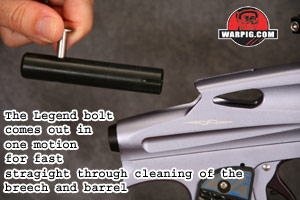 Behind the feedneck is the link pin of the bolt, flat topped for easy access. The Legend bolt is made of acetal resin, and both its back and sides are visible due to cut-outs in the body. A quick upward and rearward pull on the link pin disengages it from the hammer/ram and slides the bolt out of the marker. In a fraction of a second the Legend is field stripped for straight through cleaning of the breech and barrel as well as the bolt. The link pin is kept secure in the bolt by a spring and ball detent system which allows it to lock in one of two positions. When in the receiver, it locks the pin to the hammer/ram in the lower half of the body. Behind the feedneck is the link pin of the bolt, flat topped for easy access. The Legend bolt is made of acetal resin, and both its back and sides are visible due to cut-outs in the body. A quick upward and rearward pull on the link pin disengages it from the hammer/ram and slides the bolt out of the marker. In a fraction of a second the Legend is field stripped for straight through cleaning of the breech and barrel as well as the bolt. The link pin is kept secure in the bolt by a spring and ball detent system which allows it to lock in one of two positions. When in the receiver, it locks the pin to the hammer/ram in the lower half of the body.
The bolt is of a simple high-flow design. There are no venturi ports or o-rings, just an angled gas path from the bottom up into a hollow bolt face to allow direct gas flow to the entire rear face of the paintball.
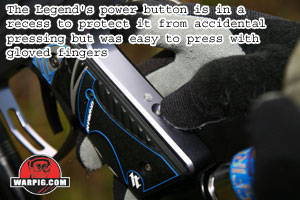 On the back of the marker's grip frame is the power button and status LED. An aluminum button lies in a recess which works well to keep it from being pressed accidentally. The Status LED is a small durable plastic lens which provides visibility to the internal WAS board's multi-color LED. On the back of the marker's grip frame is the power button and status LED. An aluminum button lies in a recess which works well to keep it from being pressed accidentally. The Status LED is a small durable plastic lens which provides visibility to the internal WAS board's multi-color LED.
Surrounding the grip frame is a Hybrid multi molded wrap around grip, and mounted at the bottom is a Custom Products ASA, ready to accept screw-in pre-set HPA systems. The Legend is an HPA only marker – it does not operate properly with CO2.
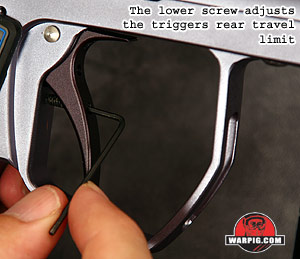 The Legend trigger features three point adjustment, with all adjustments available on the trigger – no need for opening the grip frame for tuning. A stop screw near the middle of the trigger sets the rear trigger travel limit. At the top of the trigger, a screw adjusts the strength of the magnetic trigger return by moving closer to or further away from a magnet embedded in the trigger frame. Between these two screws a third adjustment determines the point in the trigger pull where the trigger switch is activated, to fire the Legend. While the rear travel and activation point were easy to adjust, the magnetic return adjustment screw is located in a tight position which only allows a small turn at a time with the short end of a hex wrench. Fortunately, only small adjustments need to be made at this point. The Legend trigger features three point adjustment, with all adjustments available on the trigger – no need for opening the grip frame for tuning. A stop screw near the middle of the trigger sets the rear trigger travel limit. At the top of the trigger, a screw adjusts the strength of the magnetic trigger return by moving closer to or further away from a magnet embedded in the trigger frame. Between these two screws a third adjustment determines the point in the trigger pull where the trigger switch is activated, to fire the Legend. While the rear travel and activation point were easy to adjust, the magnetic return adjustment screw is located in a tight position which only allows a small turn at a time with the short end of a hex wrench. Fortunately, only small adjustments need to be made at this point.
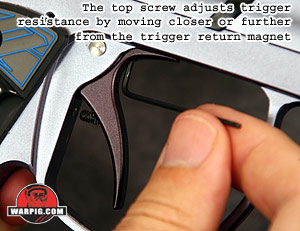 The trigger itself is of a two-finger recurved design, and its forward travel is solidly limited by a blade-like extension at its top which rests against the trigger frame. A full trigger guard surrounds the trigger and was comfortable to use with gloved hands. The trigger pivot pin is stainless steel, and threaded on one end, so that a screw with a friction lock o-ring secures it into the trigger frame. This makes changing the trigger or removing it for cleaning much easier than friction fit pin designs. The trigger pivots around the pin on dual ball bearing assemblies which provide a smooth trigger pull free from lateral movement. The layout of the trigger and grip frame allows the trigger to be removed while the grip frame is still attached to the receiver. The trigger itself is of a two-finger recurved design, and its forward travel is solidly limited by a blade-like extension at its top which rests against the trigger frame. A full trigger guard surrounds the trigger and was comfortable to use with gloved hands. The trigger pivot pin is stainless steel, and threaded on one end, so that a screw with a friction lock o-ring secures it into the trigger frame. This makes changing the trigger or removing it for cleaning much easier than friction fit pin designs. The trigger pivots around the pin on dual ball bearing assemblies which provide a smooth trigger pull free from lateral movement. The layout of the trigger and grip frame allows the trigger to be removed while the grip frame is still attached to the receiver.
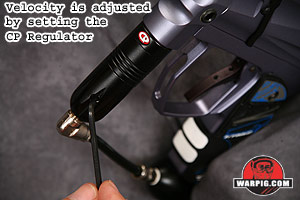 Forward of the trigger is the Legend's vertical regulator. This regulator sets the air pressure that feeds both the exhaust valve and the solenoid valve and ram assembly – there is no LPR in the Legend's design, helping to simplify maintenance. Infinity includes a Custom Products regulator – a popular aftermarket choice – as standard equipment. The regulator fits into a vertical ASA fitting, meaning it can be swapped out for any industry standard vertical reg. Pressure adjustment to the regulator sets the Legend's velocity. Forward of the trigger is the Legend's vertical regulator. This regulator sets the air pressure that feeds both the exhaust valve and the solenoid valve and ram assembly – there is no LPR in the Legend's design, helping to simplify maintenance. Infinity includes a Custom Products regulator – a popular aftermarket choice – as standard equipment. The regulator fits into a vertical ASA fitting, meaning it can be swapped out for any industry standard vertical reg. Pressure adjustment to the regulator sets the Legend's velocity.
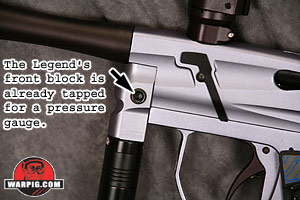 On the left side of the vertical ASA is a threaded fitting blocked by a hex-head screw. This allows the optional placement of a compact pressure gauge to monitor the marker's operating pressure. Recommended operating pressure for the Legend is 220 psi, although adjusting the marker's dwell timing will allow lower or higher pressure to be used, if for example a gentler impact with the paintball is desired, or a faster recharge rate is desired. The recommended operating pressure range is from 180 to 280 psi. On the left side of the vertical ASA is a threaded fitting blocked by a hex-head screw. This allows the optional placement of a compact pressure gauge to monitor the marker's operating pressure. Recommended operating pressure for the Legend is 220 psi, although adjusting the marker's dwell timing will allow lower or higher pressure to be used, if for example a gentler impact with the paintball is desired, or a faster recharge rate is desired. The recommended operating pressure range is from 180 to 280 psi.
Just behind the front block and ASA are the eye covers. An anodized aluminum cover on each side of the breech holds a rubber nubbin style ball detent in place as well as an infra-red emitter or detector for the Legend's anti-chop eye system.
Continue to How
It Works |





